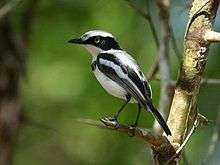Pale batis
The pale batis (Batis soror), also known as the Mozambique batis or East coast batis is a species of small bird in the wattle-eyes family, Platysteiridae. It occurs in eastern Africa, mostly in lowland miombo woodland.
| Pale batis | |
|---|---|
 | |
| male | |
.jpg) | |
| female | |
| Scientific classification | |
| Kingdom: | Animalia |
| Phylum: | Chordata |
| Class: | Aves |
| Order: | Passeriformes |
| Family: | Platysteiridae |
| Genus: | Batis |
| Species: | B. soror |
| Binomial name | |
| Batis soror | |
Description
The pale batis is an active, black, white and grey bird which is pale grey above with a black face mask bordered by a thin white supercilium, yellow eye and a pale grey back, mottled with faint white spots. It has white underparts marked with a black band across the breast in males; females have a pale rufous breast band and a similar coloured spot on the chin. The bill and legs are black. Immature birds are similar to the female except that the breast band is browner and the underparts have a buffy wash.[3] The pale batis measures 10.5–11.5 cm in length and weighs 8–13.1 g.[4]
Voice
The territorial call of the pale batis is a repeated, mournful, long and piping 3-note “pook pook pook” which is repeated up to 12 times at a constant rate,[4] with which the female duets giving excited "wik-wik" calls. Otherwise the repertoire consists of typical batis bill snaps, churrs and whistles.[3]
Distribution
Eastern Africa from coastal Kenya including the Arabuko Sokoke National Park south through eastern and south-eastern Tanzania, the islands of Zanzibar and Mafia, to Mozambique as far south as the Save River, inland to south eastern Malawi, and the east-facing slopes of the Eastern Highlands of Zimbabwe.[4]
Habitat
The pale batis typically occurs in lowland miombo woodland, normally below 500 m in coastal woodlands where there is a mosaic of forest and dense scrub.[3] Can also be found in mopane[5] and acacia around the edges of its distribution.[3] In the Eastern Highlands of Zimbabwe it is found up to 1,500 m above sea level in tall Uapaca kirkiana stands, thickets of Philippia spp. and woodland dominated mountain acacia.[3]
Habits
Little is known about the feeding habits of the pale batis, other than that it forages by gleaning insects from leaves and branches,[5] it occasionally gleans while hovering and it often joins mixed foraging parties.[3] Its social behaviour is probably similar to other batises in that it is not normally seen in groups larger than pairs or family groups, although the males may gather in single sex aggregations known as "parliaments" immediately prior to the breeding season, when they fly about excitedly, snapping their bills, fripping their wings and making "wik" calls. The male has a zigzag courtship display flight which he performs along with wing fripping, tail fanning and fluffing up the long, white spotted rump feathers while giving strident "week-week-week" calls. The females joins in the calls with her own excited "wik-wik" call.[3]
The nest of the pale batis is a small, deep cup built of thin strips of Combretum bark and fragments of grass inflorescences, held together with spiders webs. The nest is normally situated in the fork of a branch which is at least 6m above the ground, a small clutch of about 1-2 eggs is usually laid during the period September–November.[5] The female is responsible for all of the incubation and initially she carries out all the feeding of the young, the male joins in feeding when the chicks are older. Only the immediate vicinity of the nest is defended.[3]
References
- "Batis soror". IUCN Red List of Threatened Species. Retrieved 2016-11-05.
- "Batis soror Reichenow, 1903". Integrated Taxonomic Information System (ITIS) (https://www.itis.gov). Retrieved 2016-11-05.
- Harris, Tony; Franklin, Kim (2000). Shrikes and Bush-shrikes. Christopher Helm. pp. 307–309. ISBN 0-7136-3861-3.
- "East Coast Batis (Batis soror)". Handbook of the Birds of the World Alive. Lynx Edicions. Retrieved 2016-11-05.
- "Batis soror (Pale batis, Mozambique batis)". Biodiversity Explorer. Iziko Museums of South Africa. Retrieved 2016-11-05.
| Wikimedia Commons has media related to Batis soror. |
External links
- Pale batis - Species text in The Atlas of Southern African Birds.
